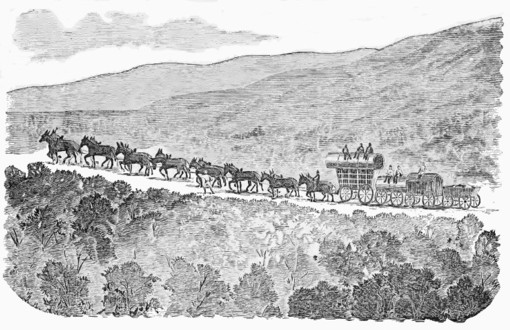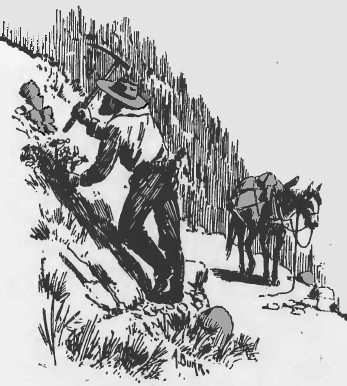Antimony:
The commercial ore of this metal is the sulfide known as
stibnite, or gray antimony. Its composition when pure is 72
per cent, antimony and 28 per cent,
sulfur. Hardness is 2; gravity, 4.5; luster, metallic; opaque; gray;
cleavage, perfect. Fracture, conchoidal. Texture, granular to massive. The
ore tarnishes quickly, is easily melted, or dissolved in hydrochloric acid.
The associated minerals are generally the ores of lead, zinc, and carbonate
of iron.
Barite may be the gangue or veinstone. Antimony is worth from 10 to
15 cents a pound. Although antimony occurs in many minerals, the only
commercial source is the sulfide, stibnite. Antimony is used as an alloy in
type metal, pewter, and babbitt metals. It is injurious to copper, even one
tenth of one per cent, reducing the value of that metal very considerably.
The price varies greatly, being now about 10 cents a pound. The composition
of stibnite is:
Stibnite, Sb2S3 71 .8 per cent Antimony.
The production of antimony in this country is not very large. The output of
1899 was but 1,250 tons, valued at $241,250. The ore is worth from $40 to
$50 a ton delivered at Staten Island, N. Y.
Mercury:
Quicksilver usually occurs in the form of cinnabar, though occasional
deposits of pure metal are found in drops and small pockets, in limestone
and the softer secondary rocks, including shales and slates. As the
appearance of quicksilver must be familiar to all,
cinnabar alone needs description. Its specific gravity is 9.0; its
hardness, 2.2. It is a red brown earthy ore, the powder of which is a dull
red. It is generally found in sandstone, though it occasionally occurs in
slates, shales and serpentine. Heated gently with lime cinnabar yields
quicksilver. If copper be held over the fumes of mercury it will be coated
with a light film of the metal. An alloy with silver has been found. Mercury
is heavy, extremely brilliant, and mobile. The composition of cinnabar is:
Cinnabar HgS 86.2 Per cent Hg.
Although but three American states have supplied this metal, this country
has held rank as second producer. Of these California is by far the most
important. Oregon and Utah having never had any but a small and spasmodic
output. Judging by Californian experience, the prospector is most likely to
find cinnabar, the ore from which the quicksilver of commerce is derived, in
metamorphic rocks. Mercury is always sold in flasks of 76 pounds. The
production of mercury by the United States (California) was 28,879 flasks in
1899, which were valued at $1,155,160. A study of the California mines shows
that serpentine is almost as intimately connected with quicksilver as is
quartz with
gold, or granite with tin. These are the things that
prospectors should make a note of. With the great increase of gold mining
and the limited store of cinnabar that is available that ore seems certain
to rise in value before long.
Nickel:
This ore is never found in metallic form, but always in combination.
Pyrrhotite, or magnetic pyrites, is the source of about all the nickel of
commerce. This ore has been already noticed under iron. Rare but valuable
ores of nickel are millerite, nickelite, glance, and nickel bloom.
Per cent nickel.
Millerite NiS 64.4
Niccolite NiAs 44.0
Some of the nickel of commerce is derived from nickel bearing pyrrhotite.
Platinum:
This metal is only found native. Its gravity is very high, from 16 to
22. Hardness, 4 to 4.5. Luster, metallic. Opaque. Whitish-gray. Smooth.
Ductile. Cleavage, none. Fracture, hackly. Texture, granular, fine. Platinum
is unaffected by acids, but if alloyed with 10 per cent of silver it
dissolves in nitric acid. Almost infusible. Platinum occurs with placer gold
in the beds of streams. Usually it is in small grains, but one or two large
nuggets are on record from Brazil and Siberia. Serpentine rocks are believed
to have originally held the platinum found in the beds of rivers, but none
has been found in veins. The entire product of the United States was 300
ounces -in 1898; valued at $3,837. In 1899 there was no recorded production.
Tin:
The composition of
casseterite, the commercial ore of tin, is SnO2 ; equal to 78.67 per
cent of metallic tin. Cassiterite or tin stone is a heavy ore which occurs
in alluvial deposits or in the beds of streams. It will be one of the latest
ores the young prospector will find himself able to name with certainty.
Granite, with white mica as one of its constituents, has so far always been
associated with tin. The American continent yields little tin, and it is not
likely the prospector in either the western states or in Canada will stumble
upon it, though a good deposit of stream tin would enrich him in a short
time, for the metal is in great demand. The streak, when the metal is
scratched with a knife point, is whitey-gray and very distinctive. Tin may
some day be found in the northern Rockies, as there is plenty of granite,
which is favorable to forming deposits of this metal. It is worth about
thirteen cents a pound, and a vein must yield more than five per cent of
metal to pay the cost of mining and dressing. Cassiterite, the principal tin
ore, would have to be roasted. Most of the European tin mines were first
worked for the copper they contained. The copper was found in the capping,
but as they gained in depth they became more and more valuable for their
tin. Some of the Cornish mines are three-quarters of a mile in depth. Very
lately tin has been discovered and mined in vast quantities in the Straits
Settlements, India. As it is found in the streams the expense of mining is
very light, and it is killing the European mines. The Cornish miners put
their tin ore on a shovel when they wish to test it. The sample is first
crushed fine and a few skillful shakes get rid of all the gangue, leaving
behind the tin and wolfram. This wolfram is always associated, in Cornwall,
with the tin and it is got rid of by roasting. Australasia and Cornwall
produce most of the tin used in commerce. Tin is not found native. Specific
gravity of cassiterite is 6.5 to 7. Hardness, 6.5 to 7. Luster, vitreous to
adamantine. Translucent to opaque. Brown, black, gray, red or yellow. Harsh.
Brittle. Massive. The appearance of this metal is so variable that nothing
but a test with reagents determines it with certainty. Granite is frequently
the country rock in which tin is found.
Zinc:
This is another ore that never occurs native. Sphalerite is the main
producing ore. Calamine or silicate of zinc was historically important.
Composition: Zinc oxide, 67 per cent; silicate, 25 per cent; water, 8 per
cent. Specific gravity, 3 to 3.7. Hardness, 4.6 to 5. Luster, vitreous.
Translucent. White. Harsh. Brittle. Cleavage, perfect. Fracture, uneven.
Texture, granular crystalline. Calamine is a difficult mineral to detect
without experience, as when impure it does not look in the least like a
metallic ore.
It would be taken for clay or shale. This ore results from the decomposition of sphalerite or sphalerite. Sphalerite contains 67 per cent zinc and 33 per cent sulfur. It is often dark brown or black from iron, otherwise it may be red, green or bluish. It is a troublesome impurity in silver ores. Smithsonite is a carbonate much resembling, and often found with, calamine. Other zinc ores are merely curiosities and do not affect the commercial value of the metal.
In the New Jersey mines the zinc ores are the oxides zincite and willemite, and the zinc-iron oxide franklinite. In the Missouri region, on the other hand, sphalerite is the typical ore. Sphalerite generally associates with the lead sulfide, galena. The Joplin district in southwestern Missouri and the adjoining region in Kansas are now mainly supplying the markets of the country, though the New Jersey deposits are very valuable. Joplin ore assaying 58 to 62 per cent has varied greatly in price during the past four years. The lowest quotation was $20 a ton, the highest $51.50. Zinc is derived mainly from the following half dozen ores :
Mineral
Formula Zinc Content.
Sphalerite ZnS. 67.0 per cent.
Zincite . ZnO 80.3 per cent.
Smithsonite ZnOCO3 51.9 per cent.
Franklinite (Variable) 5.54 per cent.
Willemite 2ZnO.SO2 58.5 per cent.
Calamine 2ZnO.SiO2.HO2 54.2 per cent.
Continue on to:
The Prospector’s Basic Mining Techniques
Return To:
Gold And Silver Basic Prospecting Methods


